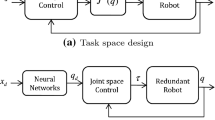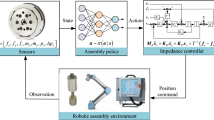Abstract
Truss structure is widely used in the aerospace field, which has good structural performance and high structural efficiency. The truss structure plays an important role in the construction of alien ground scientific research stations. Considering the time and energy required for manual assembly, autonomous assembly is a better choice than manual assembly. The installation of the truss structure without external support needs multiple dual-arm mobile robots to work cooperatively. This article analyzes the constraints of the assembly process of the truss structure, and proposes a multi-objective optimization algorithm of truss structure assembly sequence based on reinforcement learning for multi-machine collaborative assembly. Our algorithm computes an assembly sequence with short time consumption, low energy consumption and stable structure during construction for variable number of mobile dual-arm robots assembling various types of truss structures. Experiments are executed to prove that the proposed algorithm can greatly improve the efficiency of assembly. This algorithm can also be generalized and applied to other multi-robot cooperation problems.
Access this chapter
Tax calculation will be finalised at checkout
Purchases are for personal use only
Similar content being viewed by others
References
Diftler, M., Jenks, K.C., Williams, L.E.P.: Robonaut: a telepresence-based astronaut assistant//Telemanipulator and telepresence technologies VIII. Int. Soc. Opt. Photon. 4570, 142–152 (2002)
Diftler, M.A., Ahlstrom, T.D., Ambrose, R.O., et al.: Robonaut 2 – initial activities on-board the ISS. In: 2012 IEEE Aerospace Conference, pp. 1–12. IEEE (2012)
Rehnmark, F., Bluethmann, W., Rochlis, J. et al.: An effective division of labor between human and robotic agents performing a cooperative assembly task. In: Proceedings of 2003 IEEE International Conference on Humanoid Robots. Institute of Electrical and Electronics Engineers, New York, NY (2003).
Rehnmark, F., Currie, N., Ambrose, R.O., et al.: Human-centric teaming in a multi-agent EVA assembly task. SAE Trans. 1105–1113 (2004)
Guo, J., Wang, P., Cui, N.: Ant colony algorithm for assembly sequence planning of large space truss structures. In: 2007 IEEE International Conference on Control and Automation, pp. 2027–2030. IEEE (2007)
McEvoy, M., Komendera, E., Correll N.: Assembly path planning for stable robotic construction. In: 2014 IEEE International Conference on Technologies for Practical Robot Applications (TePRA), pp. 1–6. IEEE (2014)
Gunji, A.B., Deepak, B., Bahubalendruni, C.R., et al.: An optimal robotic assembly sequence planning by assembly subsets detection method using teaching learning-based optimization algorithm. IEEE Trans. Autom. Sci. Eng. 15(3), 1369–1385 (2018)
Zhu, X., Wang, C., Chen, M., et al.: Concept plan and simulation of on-orbit assembly process based on human–robot collaboration for erectable truss structure. In: International Conference on Man-Machine-Environment System Engineering, pp. 683–691. Springer, Singapore (2020).
Wang, X., Li, S., Wang, C., Chen, M., Wang, J.: Dual-arm robot based compliant assembly of space truss struts and spherical joints. Manned Spaceflight 26(6), 741–750 (2020). (in Chinese)
Zhao, C., Guo, W., Lin, R., Li, M.: An innovation design method for connector system. Mach. Des. Res. 35(5):28–31+40 (2019) (in Chinese)
Author information
Authors and Affiliations
Corresponding author
Editor information
Editors and Affiliations
Rights and permissions
Copyright information
© 2021 Springer Nature Switzerland AG
About this paper
Cite this paper
Yin, J., Chen, M., Zhang, T. (2021). Optimization Algorithm for Cooperative Assembly Sequence of Truss Structure Based on Reinforcement Learning. In: Liu, XJ., Nie, Z., Yu, J., Xie, F., Song, R. (eds) Intelligent Robotics and Applications. ICIRA 2021. Lecture Notes in Computer Science(), vol 13016. Springer, Cham. https://doi.org/10.1007/978-3-030-89092-6_43
Download citation
DOI: https://doi.org/10.1007/978-3-030-89092-6_43
Published:
Publisher Name: Springer, Cham
Print ISBN: 978-3-030-89091-9
Online ISBN: 978-3-030-89092-6
eBook Packages: Computer ScienceComputer Science (R0)




